Quantum Cybersecurity in 2025: Risks and Readiness
Understanding Quantum Cybersecurity
Quantum Cybersecurity addresses the threats quantum computing poses to traditional encryption. In 2025, algorithms like Shor’s could break RSA and ECC, exposing HTTPS, VPNs, and email security. As a result, organizations must act now to avoid future breaches. Criminals may already steal sensitive data today to decrypt it later, making early preparation essential.
Post-Quantum Cryptography Strategies
Post-Quantum Cryptography (PQC) offers algorithms resistant to quantum attacks. Therefore, businesses should begin testing standardized key-exchange and signature methods. They can evaluate performance, key sizes, and integration with existing systems before full deployment. In addition, adopting PQC builds long-term trust with customers and partners.
Hybrid Approaches for Smooth Transition
A practical way to start is by using hybrid cryptography, which combines classical and PQC algorithms. This approach keeps interoperability intact while reducing risks. Moreover, it allows gradual migration without disrupting users or creating compatibility issues with external systems.
Building a Quantum-Ready Framework
First, inventory all cryptographic assets, identifying where keys reside and which protocols are in use. Next, prioritize systems that handle long-lived or critical data. Furthermore, integrate Zero-Trust principles, rotate keys often, segment networks, and require mutual authentication. These steps strengthen defenses during the migration process.
Governance and Long-Term Planning
Finally, establish a clear roadmap approved by leadership, with timelines, responsibilities, and measurable milestones. Track PQC adoption rates, hybrid coverage, and vendor compliance. By taking action now, organizations can ensure that Quantum Cybersecurity remains a competitive advantage rather than a looming risk.
Source: NIST

